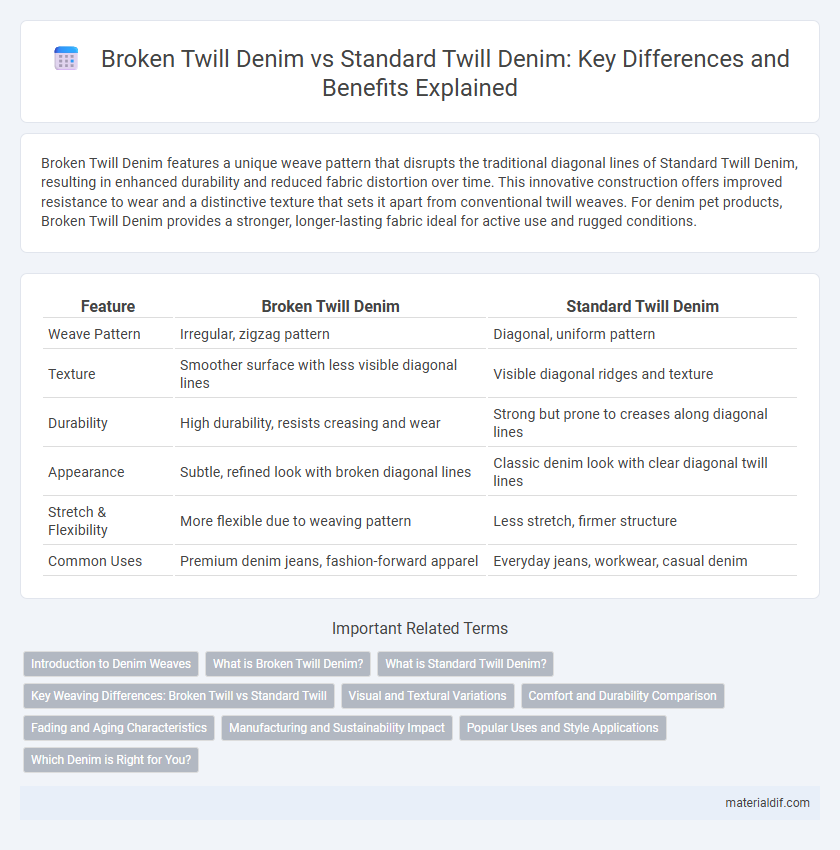Broken Twill Denim features a unique weave pattern that disrupts the traditional diagonal lines of Standard Twill Denim, resulting in enhanced durability and reduced fabric distortion over time. This innovative construction offers improved resistance to wear and a distinctive texture that sets it apart from conventional twill weaves. For denim pet products, Broken Twill Denim provides a stronger, longer-lasting fabric ideal for active use and rugged conditions.
Table of Comparison
| Feature | Broken Twill Denim | Standard Twill Denim |
|---|---|---|
| Weave Pattern | Irregular, zigzag pattern | Diagonal, uniform pattern |
| Texture | Smoother surface with less visible diagonal lines | Visible diagonal ridges and texture |
| Durability | High durability, resists creasing and wear | Strong but prone to creases along diagonal lines |
| Appearance | Subtle, refined look with broken diagonal lines | Classic denim look with clear diagonal twill lines |
| Stretch & Flexibility | More flexible due to weaving pattern | Less stretch, firmer structure |
| Common Uses | Premium denim jeans, fashion-forward apparel | Everyday jeans, workwear, casual denim |
Introduction to Denim Weaves
Broken twill denim features an irregular diagonal weave pattern that reduces the visible lines found in standard twill denim, offering a unique texture and enhanced durability. Standard twill denim is characterized by a consistent diagonal rib pattern created by weaving the weft thread over two or more warp threads, providing strength and flexibility. Both weaves impact the fabric's appearance, durability, and comfort, making them essential choices in denim production.
What is Broken Twill Denim?
Broken twill denim features a weave pattern where the diagonal lines are intentionally disrupted or reversed, creating a zigzag texture that reduces the visible diagonal twill line prominent in standard twill denim. This weave enhances fabric strength and durability while minimizing the dark side appearance commonly found in traditional twill, resulting in unique fading characteristics over time. Broken twill denim is especially favored for its aesthetic variation and improved resistance to wear compared to the smoother, more uniform surface of standard twill denim.
What is Standard Twill Denim?
Standard twill denim features a diagonal weave pattern created by weaving the weft thread under two or more warp threads, resulting in a smooth, consistent texture with a clear diagonal rib. This traditional weave enhances denim's durability and allows for distinctive fading patterns over time. Commonly used in classic blue jeans, standard twill denim provides a balanced combination of strength and flexibility.
Key Weaving Differences: Broken Twill vs Standard Twill
Broken twill denim features a weaving pattern where the twill direction alternates, creating a zigzag effect that reduces diagonal lines and enhances fabric durability. Standard twill denim employs a consistent diagonal weave, typically either left-hand or right-hand twill, resulting in a uniform pattern and classic denim appearance. These weaving differences affect texture, wear resistance, and the overall aesthetic of denim garments.
Visual and Textural Variations
Broken twill denim features a distinctive diagonal weave pattern that interrupts the traditional continuous diagonal of standard twill, creating a more varied and visually dynamic surface. This structure results in enhanced texture with subtle ridges and irregularities, providing a unique tactile feel compared to the smoother and uniform finish of standard twill denim. The broken twill's angular, zigzag appearance often leads to richer color-depth variations through fading, giving denim garments a more individualized and rugged aesthetic.
Comfort and Durability Comparison
Broken twill denim features a diagonal weave pattern that reduces fabric stiffness, resulting in enhanced comfort and flexibility compared to standard twill denim's traditional diagonal weave. This weave innovation also decreases fabric wear and tear by distributing stress more evenly, improving the durability and lifespan of broken twill denim. Standard twill denim, while durable due to its tight weave, can feel stiffer and may break down faster under repeated movement, making broken twill a preferred choice for comfort-focused, long-lasting denim garments.
Fading and Aging Characteristics
Broken twill denim features a zigzag weave pattern that disrupts the diagonal lines seen in standard twill, resulting in more even wear and slower fading over time. Standard twill denim showcases a pronounced diagonal weave that leads to quicker fading along those lines, creating a distinct contrast and prominent whiskering. The unique structure of broken twill denim enhances durability and develops subtle, uniform aging patterns, making it ideal for those seeking restrained vintage aesthetics.
Manufacturing and Sustainability Impact
Broken twill denim features a weaving pattern that disrupts the traditional diagonal lines found in standard twill denim, resulting in a more flexible fabric that requires less intensive mechanical finishing during manufacturing. The altered weave structure enhances durability and reduces surface wear, which can extend garment lifespan and decrease the frequency of replacement, supporting sustainability goals. Standard twill denim typically involves heavier water and chemical usage in the finishing process to achieve desired softness and appearance, whereas broken twill's inherent texture minimizes these resource-intensive treatments.
Popular Uses and Style Applications
Broken twill denim is favored in streetwear and casual fashion for its diagonal pattern that creates a unique, textured appearance, offering enhanced durability and reduced diagonal fading compared to standard twill denim. Standard twill denim, characterized by its traditional diagonal weave, is commonly used in classic jeans, jackets, and workwear due to its strength and timeless style appeal. Popular style applications for broken twill include distressed and vintage-inspired pieces, while standard twill remains a staple in everyday denim garments with clean lines and versatile wearability.
Which Denim is Right for You?
Broken twill denim features an irregular weaving pattern that reduces the strong diagonal lines found in standard twill denim, offering a softer hand feel and quicker wear-in process. Standard twill denim is known for its distinct diagonal ribs and durability, making it ideal for those seeking a classic look with long-lasting strength. Choose broken twill denim if you prefer subtle texture and comfort, while selecting standard twill denim suits those prioritizing traditional style and rugged resilience.
Broken Twill Denim vs Standard Twill Denim Infographic

 materialdif.com
materialdif.com